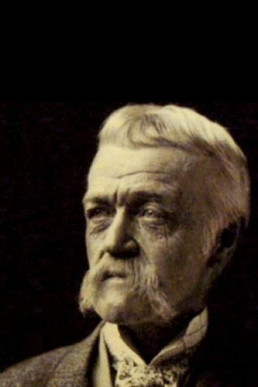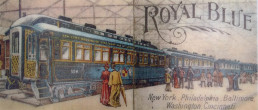The Aberdeen B&O Station’s History
The train station was built in 1885, one of many in the eastern United States designed by the renowned 19th century architect Frank Furness. Mr. Furness constructed 24 of the 36 stations on the B&O’s new Philadelphia line which opened in 1886. This line was going to allow the B&O to connect Washington, D.C., to New York City. Their goal was to compete with their rival, the Pennsylvania Railroad.
The train station was central to the economy and culture of the city of Aberdeen from its opening in 1886 to the ending of passenger service in 1958. With the opening of this line, freight and passenger service become available to Aberdeen south to Baltimore and north to Philadephia and New York. The station was a key factor in the canning industry, since it was used by canners for shipping their products nationwide. In 1917, the federal government purchased large amounts of Aberdeen’s best farmland for the Aberdeen Proving Grounds, greatly diminishing the canning industry of Aberdeen. The trains that stopped at the B&O station were then used for transporting troops, military supplies, and workers through two World Wars. Daily, local citizens departed from, and arrived at, the Aberdeen B&O station until 1958 when passenger service on the line was suspended.
After passenger service between Baltimore and Philadelphia was terminated, the station was then used for freight, track gangs, signal maintainers and equipment storage into the early 1990s, before the railroad boarded it up and left it to the elements.
For more history on how railroads, including the B&O and this station, shaped and influenced Aberdeen check out this three part series from Charlotte Cronin via The Baltimore Sun:
I Railroads played important role in Aberdeen’s history
II Rail traffic through Aberdeen included mail, passengers
III The story of two rail lines through Aberdeen helping the city to develop
A legacy of a brilliant architect: Frank Furness and the Aberdeen B&O Station
The most important factor of significance for the Aberdeen B&O station, other than it being from 1885, is that it was designed by the noted architect and Civil War Veteran/ Congressional Medal of Honor awardee, Frank Heyling Furness–in fact, 25 years after fighting in the Battle of Gettysburg, he designed the monument to his regiment on South Cavalry Field.
Frank Furness was one of the pre-eminent American architects of the Victorian era, whose distinctive style and buildings over all kinds–many of them railroad stations both large and small, could be found all around Furness’ native Philadelphia and surrounding areas–in his lifetime he designed over 600 buildings! Furness was a founder of the Philadelphia Chapter of the American Institute of Architects.
Because of his success, he was one of the most highly paid architects of his era, and nearly 1/3 of his commissions are reported to have come from railroads! He designed railroad stations for the infamous Reading Railroad, Pennsylvania Railroad, and of course the B&O Railroad.
The Aberdeen Station is one of only two surviving stations that Mr. Furness designed for the B&O railroad, and is the last station remaining that was built with one of the “standard” designs.
Some of the Aberdeen Station’s architectural features, as described by James T. Wollen, Jr., A.I.A. in the Harford Historical Bulletin, Number 54, are as followed: “Its design is deliberately picturesque, typical of its era; asymmetrical, a brick base with shingle walls, broad, low hipped roof, wide sheltering overhangs supported by shaped wooden brackets, differing yet related window and door openings.”
Aberdeen’s station is the last one standing along the former Royal Blue Line north of Baltimore. Even the B&O’s distinctive terminal designed by Furness in central Philadelphia has been gone 50 years.
Want to know more about Frank Furness and the architectural legacy he left around historic Philadelphia? Check out this article here to see some of his most prestigious work–that can be seen and enjoyed today!
Aberdeen Station and The Royal Blue Line
Aberdeen’s B&O station was a stop along that Royal Blue Line–the B&O Railroad’s luxury passenger line between Washington, D.C., and New York. The Royal Blue was in operation from 1890 to 1958 and was created to compete with the rival Pennsylvania Railroad’s D.C.-to-New York passenger service, according to historians, such as, Paul Bridge, a volunteer historian with the B&O Railroad Museum in Baltimore, mentioned in a quote from an article in the Baltimore Sun, below:
“The B&O could not enter New York because of the presence of the Pennsylvania Railroad, who controlled that whole region,” he said.
Bridge noted the B&O had to build its own rail line to Philadelphia during the 1880s because of the Pennsylvania Railroad’s dominance in the Northeast.
The Royal Blue was known for its Pullman cars with their distinctive blue-and-gray color schemes, and its top-notch service, which included dining cars, observation cars and even baby-sitters and nurses for children.
‘You can be sure you were going to get first-class service,” Bridge said.
The trains were pulled by steam and diesel-powered locomotives. Bridge showed a photo of a diesel Streamliner locomotive from the early 1950s.
“That’s what you usually think of when you think of the Royal Blue Line and its rolling stock,” Bridge said. “The real benchmark, though, was passenger comfort.”
Bob Tarring said he remembers taking the Royal Blue “back and forth to Philadelphia and New York and Baltimore with my grandmother.”
Wally Hawtin said he grew up in Aberdeen, two doors from the B&O station. He said he remembers seeing Royal Blue trains go by his house.
“I remember them,” he said. “They were beautiful.”
Aberdeen was a regular station stop for many Royal Blue Line trains but despite the B&O’s many innovations on the line in the decades after service began, business began to decline rapidly following World War II, as was the case with many passenger railroads. All B&O passenger service north of Baltimore was abandoned in 1958, with the final Royal Blue Service train running on April 26, 1958.
Looking to the Future
The train station was constructed in 1885 and essentially remained the same until a rear
dormer was added in the early 1950s. The Friends plan to restore the station to its original 1885 specifications, as well as help it to become an important part of the City of Aberdeen once again!
The station is eligible for the Maryland Register of Historic Properties and is eligible for inclusion on the National Register of Historic Places.
The B&O Train Station is one of the last public historic buildings in the City of Aberdeen. The Station is part of the Main Street designation for the City of Aberdeen. Once it is rehabilitated, it will provide an appealing and historically appropriate entrance to the downtown. It is our hope that the restored station would serve as an tourism and economic catalyst for expansion of Main Street.
In April 2022, the Aberdeen B& O Train Station was awarded $850,000 in State bonds. Governor Lawrence J. Hogan and the 2022 Maryland General Assembly awarded the funding through the efforts of Senator Robert Cassilly and Delegate Steven Johnson.
In August 2024, the exterior will be completed. After the exterior restoration is completed, the Friends needs to build ADA acccesible access, create a parking lot and landscape the grounds.







